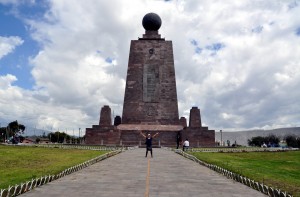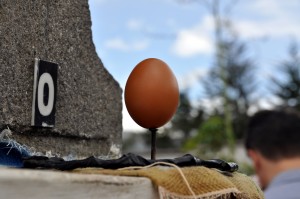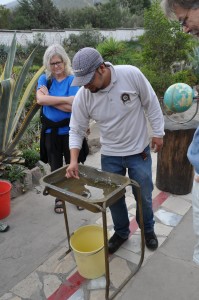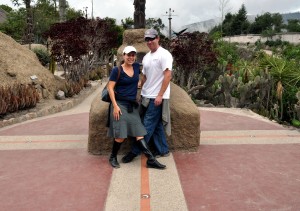Approximately 20 kilometers north of downtown Quito, smack through the middle of Ecuador, stands the official marker for the Equator…but does it really mark the fabled line? It appears the answer is not quite as rock-solid as the materials used to build the marker.
The “Mitad del Mundo” (or ‘Middle of the World’) is a large, government-sanctioned official marker visited by tour buses, private tourists and public transit about one hour outside of Ecuador’s capital city. In addition to an impressive stone monument with a “mundo” on the top and official-looking painted lines running out both sides of the marker, this attraction features numerous restaurants, gift shops and kids’ play areas. Admission is $3 per foreigner and visitors tromp around the grounds, taking the requisite photos with feet/arms/heads and more straddling the signature line.

But is this really the ‘Middle of the World’? Depends who you ask.
The government opened this marker about 30 years ago; it’s conveniently located near a large traffic roundabout and sits on several acres of open space. However, some scientists believe this marker is actually not on 0 latitude. A very un-official, non-government museum stands about 200 meters to the south and claims to be the true Equator, calculated by GPS as 0.0.0 degrees.
To get to the Inti Nan (or ‘Road to the Sun’) museum, you exit the official monument and head left onto a busy road, clinging to a small strip of dirt along an embankment. When you see the small painted sign, turn left again and walk uphill along a dirt path into the entrance of Inti Nan. There are no uniformed soldiers or official ticket takers here.

You do pay an admission to the museum; $2 instead of $3. There is staff that provides guided tours in English, Spanish, German and other languages. During your approximately 45-minute visit, you get a lot more for your admission than at the government site. You’ll visit a small museum showing artifacts from Inca heritage, head shrinking techniques and a replicated series of homes and huts.
The real fun comes when you get to the “experiment” portion of the tour. Here, led by your guide, you take part in countless science exercises designed to prove you are on the Equator. For example, our group whooped in cheer whenever one of us were able to successfully balance an egg on the head of a nail, supposedly only possible where the gravity is exactly balanced. We walked the “line,” getting dizzy from the effect of two different hemispheric rotations pulling at us.

Speaking of rotation, the centerpiece demonstrations of this tour are the water drainage exercises…On the north side, the south side and exactly on the Equator. The water did spin one way, then the opposite and then drain straight down. However, some questioned the possibility of moving a sink of water 10-20 feet to accurately show a difference in the Coriolis Effect. Did our tour guide start a swirl based on how he pulled out the plug? You can believe in the experiments or not, but it’s undeniable that this museum is definitely more entertaining than the sanctioned marker.
So is Inti Nan the Real Equator? Hard to say. There’s no actual GPS device at the museum to prove their 0.0.0 claim. It’s debated on blogs and and in posts around the web, with several travelers attempting to mark the Equator via iPhone, Garmin or other technology. Some have it at Inti Nan, while others have it just outside, on the street. Regardless of which (or neither) is the real Equator, both merit a visit when in Quito!



